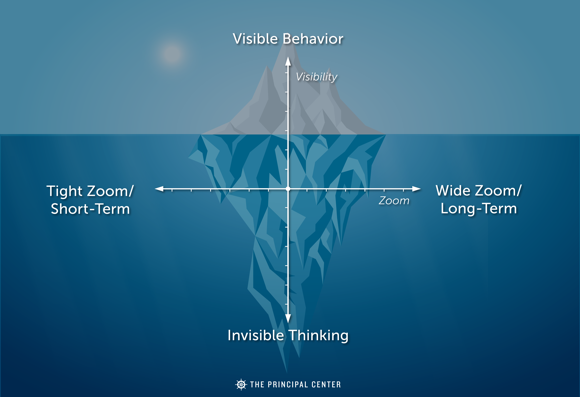| Is teacher practice always something we can actually see in an observation? Sometimes, the answer is clearly yes. But as I've argued over the past few emails, it's not always so simple. I thought it might be helpful to plot this visually, along two axes. Let's call this the Evidence of Practice Grid: |

| If a teaching practice falls in the top-left quadrant, it's probably something you can directly observe, There's still an “observer effect”—teachers can easily put on a song and dance to show you what you want to see—but at least the practice itself is fundamentally see-able. If it's in the top-right quadrant, a practice may be visible, but not on the time scale of a typical classroom visit. It might take weeks or months for the practice to play out—for example, building relationships with students. The bottom two quadrants include what Charlotte Danielson calls the “cognitive” work of teaching—the thinking and decision-making that depend on teachers' professional judgment. These “beneath the surface” aspects of practice are huge, but we can't observe them directly. We must talk with teachers to get at them. So, for any given practice, we can figure out how visible it is, and how long it takes to play out, using this grid. That's the Evidence of Practice Grid. The horizontal axis in our diagram is zoom—the “grain size” or time scale of the practice. The vertical axis in our diagram is visibility—how directly observable the practice is. So how can this grid be useful? If you're focusing on an area of practice that's on the bottom or to the right, the grid can help you realize that it's something that's hard to directly observe. With this knowledge, you can stop yourself and say “Wait…did I actually see conclusive evidence for this Conversely, when you know you're looking at a tight-zoom, highly visible practice, you don't have to shy away from giving immediate feedback. And in all cases, if you want to know more than observation alone can tell you… You can ask. You can get the teacher talking. Conversation makes the invisible visible—and therefore, useful for growth and evaluation. Hope this is helpful! As you gather evidence of teacher Make sure you're aware of the zoom level and visibility of the practice you're focusing on. Make sense? Give it a try now: Plot a given practice on this grid—mentally—and think about Where does it fall? What comes up when you try to observe for or give feedback on this area of teacher practice? |
